| Listing 1 - 10 of 34 | << page >> |
Sort by
|
Book
Year: 2006 Publisher: Champaign, IL : Human Kinetics,
Abstract | Keywords | Export | Availability | Bookmark
 Loading...
Loading...Choose an application
- Reference Manager
- EndNote
- RefWorks (Direct export to RefWorks)
In the groundbreaking text, Movement System Variability, internationally known scientists synthesize the latest research in the study of variability in the human movement system and provide an in-depth, multi-disciplinary analysis for researchers in human movement sciences and related fields. Movement System Variability's unique dynamic systems perspective in most chapters adds a new theoretical interpretation to the role of variability in movement behavior. A rich array of scientific disciplines is represented in the text to offer insights into the nature and role of variability observed at different levels of analysis. Movement System Variability is organized into five parts: Behavioral Analysis of Variability in the Movement System; Variability, Performance and Excellence; Issues in Measurement; Variability Across the Lifespan; Variability Within Subsystems. This essential reference book provides fresh insights into the nature and function of variability. Just as important, it demonstrates how an understanding of variability can enhance the practice of educators, teachers, coaches, physiotherapists, and developmental specialists. This book is an ideal reference for researchers or students interested in the human movement sciences.
Human locomotion. --- Musculoskeletal system --- Efferent pathways --- Variation.
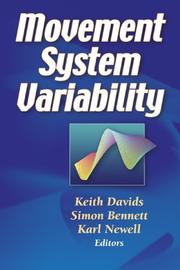
ISBN: 0736044825 9780736044820 Year: 2006 Publisher: Champaign : Human kinetics.
Abstract | Keywords | Export | Availability | Bookmark
 Loading...
Loading...Choose an application
- Reference Manager
- EndNote
- RefWorks (Direct export to RefWorks)
Efferent pathways --- Human locomotion --- Musculoskeletal system --- Variation
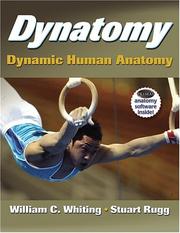
ISBN: 0736036822 Year: 2006 Publisher: Champaign : Human Kinetics,
Abstract | Keywords | Export | Availability | Bookmark
 Loading...
Loading...Choose an application
- Reference Manager
- EndNote
- RefWorks (Direct export to RefWorks)
Human anatomy. --- Human locomotion. --- Musculoskeletal system. --- Anatomy. --- Movement. --- Anatomy --- Movement
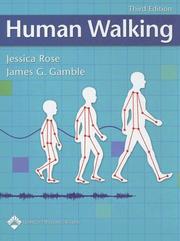
ISBN: 0781759544 9780781759540 Year: 2006 Publisher: Philadelphia, Pa Lippincott
Abstract | Keywords | Export | Availability | Bookmark
 Loading...
Loading...Choose an application
- Reference Manager
- EndNote
- RefWorks (Direct export to RefWorks)
The definitive text on human gait is now in its Third Edition& thoroughly revised to reflect recent advances in the study of human locomotion and the clinical use of gait analysis. The book features contributions from leading experts in all the disciplines involved in the study, assessment, and treatment of gait disorders, including physical medicine and rehabilitation, orthopaedics, neurology, physical therapy, podiatry, kinesiology, and biomedical engineering. This edition's updated chapters have a greater focus on analysis of treatment outcomes. Five new chapters cover evolution of human walking; adaptation in pregnancy, aging, and alcoholism; walking for health; simulation of gait; and ten important take-home lessons about walking.
Physiotherapy. Alternative treatments --- lopen --- biomechanica --- bewegingsapparaat --- kinesitherapie --- Physiology: movement organs, voice and skin --- Biomechanica --- Motoriek --- Mensen : bewegingsleer --- 612.7 --- Walking. --- Locomotion --- Walking --- Biomechanics. --- Gait --- physiology. --- Pedestrianism --- Aerobic exercises --- Animal locomotion --- Athletics --- Human locomotion
Dissertation
ISBN: 9789080908475 9080908479 Year: 2006 Publisher: Gent Universiteit Gent. Faculteit Geneeskunde en Gezondheidswetenschappen. Vakgroep Bewegings- en Sportwetenschappen
Abstract | Keywords | Export | Availability | Bookmark
 Loading...
Loading...Choose an application
- Reference Manager
- EndNote
- RefWorks (Direct export to RefWorks)
Beweging [Menselijke ] --- Gait [human ] --- Human gait --- Human locomotion --- Locomotion humaine --- Menselijke beweging --- Sciences and engineering --- health sciences --- general --- biological sciences --- biophysics --- general. --- Biological sciences --- Biophysics --- General. --- Health sciences
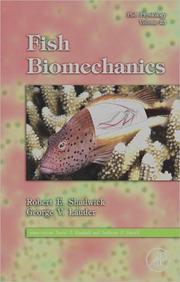
ISBN: 9780123504470 0123504473 9786611050412 1281050415 0080477763 9780080477763 Year: 2006 Publisher: Amsterdam Boston Academic Press
Abstract | Keywords | Export | Availability | Bookmark
 Loading...
Loading...Choose an application
- Reference Manager
- EndNote
- RefWorks (Direct export to RefWorks)
The first in two decades to exclusively integrate physiological and biomechanical studies of fish locomotion, feeding and breathing, making this book both comprehensive and unique. This book reviews and integrates recent developments in research on fish biomechanics, with particular emphasis on experimental results derived from the application of innovative new technologies to this area of research, such as high-speed video, sonomicrometry and digital imaging of flow fields. The collective chapters, written by leaders in the field, provide a multidisciplinary view and synthesis of the latest i
612.76 --- 597 --- 591.17 --- 591.131 --- 591.17 Movement. Locomotion. Physiology of the skeleton and organs of locomotion --- Movement. Locomotion. Physiology of the skeleton and organs of locomotion --- 597 Pisces. Fishes. Ichthyology --- Pisces. Fishes. Ichthyology --- 591.131 Seizure and comminution of food --- Seizure and comminution of food --- Locomotie. Beweging. Lichaamsmechanica. Biomedische ingenieurstechnieken --- Locomotion. Principles of animal mechanics. Biomedical engineering --- Biomechanics --- Fishes --- Biological mechanics --- Mechanical properties of biological structures --- Biophysics --- Mechanics --- Contractility (Biology) --- Physiology --- Biomechanics. --- Physiology.
Book
ISBN: 9086590098 Year: 2006 Publisher: Amsterdam VU Uitgeverij
Abstract | Keywords | Export | Availability | Bookmark
 Loading...
Loading...Choose an application
- Reference Manager
- EndNote
- RefWorks (Direct export to RefWorks)
De patiënt die door hemiplegie wordt getroffen krijgt te maken met beperkingen van allerlei basisvaardigheden. Men spreekt dan van functionaliteitsproblemen. De behandeling ervan is een belangrijk aspect van de revalidatie en vormt een leerproces dat tot doel heeft die vaardigheden weer zelfstandig te kunnen uitvoeren. Om de patiënt daarbij te helpen is het nodig dat alle betrokken behandelaars – binnen het instituut, maar ook binnen de keten – optimaal met elkaar samenwerken, zo ook met hun collega’s in de eerste lijn

ISBN: 0736059091 9780736059091 Year: 2006 Publisher: Z.p. Human Kinetic Publishers
Abstract | Keywords | Export | Availability | Bookmark
 Loading...
Loading...Choose an application
- Reference Manager
- EndNote
- RefWorks (Direct export to RefWorks)
Human anatomy. --- Human locomotion. --- Movement. --- Musculoskeletal Physiology. --- Musculoskeletal System --- Musculoskeletal system --- anatomy & histology. --- Anatomy. --- Anatomie --- Menskunde --- Bewegingsleer (fysiologie) --- Tekenen
Book
Abstract | Keywords | Export | Availability | Bookmark
 Loading...
Loading...Choose an application
- Reference Manager
- EndNote
- RefWorks (Direct export to RefWorks)
Bones --- Evolution --- Extinct mammals --- Locomotion --- Mammals, Fossil --- New World monkeys --- New World monkeys, Fossil --- Paleontology --- Paralouatta --- Skeleton --- Antilles, Greater
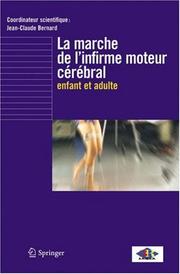
ISBN: 2287251804 9782287251801 9786610614134 1280614137 2287278222 Year: 2006 Publisher: Paris: Springer,
Abstract | Keywords | Export | Availability | Bookmark
 Loading...
Loading...Choose an application
- Reference Manager
- EndNote
- RefWorks (Direct export to RefWorks)
Les patients porteurs d’une Infirmité Motrice Cérébrale (IMC) sont confrontés à de nombreux problèmes neuromoteurs liés aux dommages cérébraux dont les conséquences fonctionnelles, dans les premières années de vie, ont un retentissement sur l’acquisition de la marche. Une meilleure connaissance de la marche et de ses niveaux de contrôle ainsi qu’une analyse clinique affinée et quantifiée au laboratoire permettent de définir des options thérapeutiques en collaboration avec le patient, sa famille et l’équipe soignante. La lutte contre les troubles du tonus et les troubles neuro-orthopédiques constitue le quotidien des patients à tous les âges de la vie. Les patients IMC bénéficient de plus en plus fréquemment de thérapeutiques médicamenteuses nouvelles, d’une adaptation régulière des aides de marche et des orthèses ainsi que d’une rééducation spécifique associée ou non à des gestes chirurgicaux qu’ils soient orthopédiques ou neurologiques
Gait Disorders, Neurologic --- Cerebral Palsy --- Gait disorders --- Cerebral palsy --- Locomotion, Troubles de la --- Infirmité motrice cérébrale --- Orthopedic apparatus. --- Walking. --- Treatment. --- Infirmité motrice cérébrale --- EPUB-LIV-FT LIVMEDEC LIVSANTE SPRINGER-B --- Cerebral palsied children --- Enfants infirmes moteurs cérébraux --- therapy --- Réadaptation --- Thérapeutique --- therapy. --- Gait Disorders, Neurologic. --- Cerebral Palsy. --- Réadaptation. --- Thérapeutique. --- Pedestrianism --- Aerobic exercises --- Animal locomotion --- Athletics --- Human locomotion --- Apparatus, Orthopedic --- Orthoses --- Orthotic devices --- Surgical instruments and apparatus --- Cerebral paralysis --- Little's disease --- Paralysis, Cerebral --- Brain damage --- Extrapyramidal disorders --- Developmental disabilities --- Paralysis, Spastic --- Enfants infirmes moteurs cérébraux --- Réadaptation. --- Thérapeutique.
| Listing 1 - 10 of 34 | << page >> |
Sort by
|

 Search
Search Feedback
Feedback About UniCat
About UniCat  Help
Help News
News